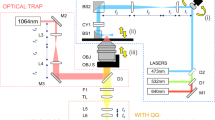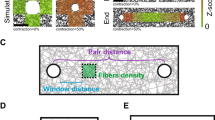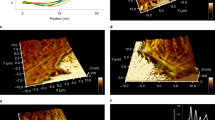Abstract
Regulation of cell functions by the physical properties of the extracellular matrix (ECM) has emerged as a crucial contributor to development and disease. Two specific physical properties of the ECM, stiffness and dimensionality, each influence cell signaling and function. As these ECM physical properties are linked to other properties that also regulate cell behavior, e.g., integrin ligand density, parsing the specific contributions of ECM stiffness and dimensionality has proven difficult. Here we detail a simple protocol, which can be completed in 1–2 d, for combining three-dimensional (3D) ECM engagement with controlled underlying ECM stiffness. In these 'sandwich gels', cells are sandwiched between a 3D fibrillar ECM and an ECM-coupled polyacrylamide gel of defined compliance, allowing the study of the specific effects of ECM compliance on cell function in physiologically relevant 3D ECMs. This type of system enables high-resolution time-lapse imaging and is suitable for a wide range of cell types and molecular perturbations.
This is a preview of subscription content, access via your institution
Access options
Subscribe to this journal
Receive 12 print issues and online access
$259.00 per year
only $21.58 per issue
Buy this article
- Purchase on Springer Link
- Instant access to full article PDF
Prices may be subject to local taxes which are calculated during checkout


Similar content being viewed by others
References
Ghosh, K., Thodeti, C.K., Dudley, A.C., Mammoto, A. & Klagsbrun, M. et al. Tumor-derived endothelial cells exhibit aberrant Rho-mediated mechanosensing and abnormal angiogenesis in vitro. Proc. Natl. Acad. Sci. USA 105, 11305–11310 (2008).
Ingber, D.E. Mechanical signaling and the cellular response to extracellular matrix in angiogenesis and cardiovascular physiology. Circ. Res. 91, 877–887 (2002).
Mammoto, A., Connor, K.M., Mammoto, T., Yung, C.W. & Huh, D. et al. A mechanosensitive transcriptional mechanism that controls angiogenesis. Nature 457, 1103–1108 (2009).
Discher, D.E., Janmey, P. & Wang, Y.L. Tissue cells feel and respond to the stiffness of their substrate. Science 310, 1139 (2005).
Pelham, R.J. Jr. & Wang, Y.L. Cell locomotion and focal adhesions are regulated by the mechanical properties of the substrate. Biol. Bull. 194, 348–349 (1998).
Saez, A., Ghibaudo, M., Buguin, A., Silberzan, P. & Ladoux, B. Rigidity-driven growth and migration of epithelial cells on microstructured anisotropic substrates. Proc. Natl. Acad. Sci. USA 104, 8281–8286 (2007).
Beningo, K.A., Dembo, M. & Wang, Y.L. Responses of fibroblasts to anchorage of dorsal extracellular matrix receptors. Proc. Natl. Acad. Sci. USA 101, 18024–18029 (2004).
Even-Ram, S., Doyle, A.D., Conti, M.A., Matsumoto, K. & Adelstein, R.S. et al. Myosin IIA regulates cell motility and actomyosin-microtubule crosstalk. Nat. Cell Biol. 9, 299–399 (2007).
Engler, A.J., Sen, S., Sweeney, H.L. & Discher, D.E. Matrix elasticity directs stem cell lineage specification. Cell 126, 677–689 (2006).
Tilghman, R.W., Cowan, C.R., Mih, J.D., Koryakina, Y. & Gioeli, D. et al. Matrix rigidity regulates cancer cell growth and cellular phenotype. PLoS One 5, e12905 (2010).
Wang, N., Naruse, K., Stamenovic, D., Fredberg, J.J. & Mijailovich, S.M. et al. Mechanical behavior in living cells consistent with the tensegrity model. Proc. Natl. Acad. Sci. USA 98, 7765–7770 (2001).
Lo, C.M., Wang, H.B., Dembo, M. & Wang, Y.L. et al. Cell movement is guided by the rigidity of the substrate. Biophys. J. 79, 144–152 (2000).
Kong, H.J., Liu, J., Riddle, K., Matsumoto, T. & Leach, K. et al. Non-viral gene delivery regulated by stiffness of cell adhesion substrates. Nat. Mater. 4, 460–464 (2005).
Mammoto, A., Mammoto, T. & Ingber, D.E. Mechanosensitive mechanisms in transcriptional regulation. J. Cell Sci. 125, 3061–3073 (2012).
le Duc, Q., Shi, Q., Blonk, I., Sonnenberg, A. & Wang, N. et al. Vinculin potentiates E-cadherin mechanosensing and is recruited to actin-anchored sites within adherens junctions in a myosin II-dependent manner. J. Cell Biol. 189, 1107–1115 (2010).
Baker, E.L., Lu, J., Yu, D., Bonnecaze, R.T. & Zaman, M.H. et al. Cancer cell stiffness: integrated roles of three-dimensional matrix stiffness and transforming potential. Biophys. J. 99, 2048–2057 (2010).
Baker, R., Rogers, K.D., Shepherd, N. & Stone, N. New relationships between breast microcalcifications and cancer. Br. J. Cancer 103, 1034–1039 (2010).
Egeblad, M., Rasch, M.G. & Weaver, V.M. Dynamic interplay between the collagen scaffold and tumor evolution. Curr. Opin. Cell Biol. 22, 697–706 (2010).
Wang, Y.L. & Pelham, R.J. Jr. Preparation of a flexible, porous polyacrylamide substrate for mechanical studies of cultured cells. Methods Enzymol. 298, 489–496 (1998).
Frey, M.T., Engler, A., Discher, D.E., Lee, J. & Wang, Y.L. Microscopic methods for measuring the elasticity of gel substrates for cell culture: microspheres, microindenters, and atomic force microscopy. Methods Cell Biol. 83, 47–65 (2007).
Weigelt, B., Lo, A.T., Park, C.C., Gray, J.W. & Bissell, M.J. HER2 signaling pathway activation and response of breast cancer cells to HER2-targeting agents is dependent strongly on the 3D microenvironment. Breast Cancer Res. Treat. 122, 35–43 (2009).
Dunn, J.C., Tompkins, R.G. & Yarmush, M.L. Hepatocytes in collagen sandwich: evidence for transcriptional and translational regulation. J. Cell Biol. 116, 1043–1053 (1992).
Dunn, J.C., Yarmush, M.L., Koebe, H.G. & Tompkins, R.G. Hepatocyte function and extracellular matrix geometry: long-term culture in a sandwich configuration. FASEB J. 3, 174–177 (1989).
Erler, J.T. & Weaver, V.M. Three-dimensional context regulation of metastasis. Clin. Exp. Metastasis 26, 35–49 (2009).
Pankov, R., Endo, Y., Even-Ram, S., Araki, M. & Clark, K. et al. A Rac switch regulates random versus directionally persistent cell migration. J. Cell Biol. 170, 793–802 (2005).
Petrie, R.J., Doyle, A.D. & Yamada, K.M. Random versus directionally persistent cell migration. Nat. Rev. Mol. Cell Biol. 10, 538–549 (2009).
Beningo, K.A. & Wang, Y.L. Double-hydrogel substrate as a model system for three-dimensional cell culture. Methods Mol. Biol. 370, 203–212 (2007).
Rehfeldt, F., Brown, A.E., Raab, M., Cai, S. & Zajac, A.L. et al. Hyaluronic acid matrices show matrix stiffness in 2D and 3D dictates cytoskeletal order and myosin-II phosphorylation within stem cells. Integr. Biol. (Camb.) 4, 422–430 (2012).
Ezzell, R.M., Toner, M., Hendricks, K., Dunn, J.C. & Tompkins, R.G. et al. Effect of collagen gel configuration on the cytoskeleton in cultured rat hepatocytes. Exp. Cell Res. 208, 442–452 (1993).
Myers, K.A., Applegate, K.T., Danuser, G., Fischer, R.S. & Waterman, C.M. et al. Distinct ECM mechanosensing pathways regulate microtubule dynamics to control endothelial cell branching morphogenesis. J. Cell Biol. 192, 321–334 (2011).
Harunaga, J.S. & Yamada, K.M. Cell-matrix adhesions in 3D. Matrix Biol. 30, 363–369 (2011).
Shakesheff, K.M. & Rose, F.R. Tissue engineering in the development of replacement technologies. Adv. Exp. Med. Biol. 745, 47 (2012).
Huh, D., Hamilton, G.A. & Ingber, D.E. From 3D cell culture to organs-on-chips. Trends Cell Biol. 21, 745–754 (2011).
Hutmacher, D.W., Horch, R.E., Loessner, D., Rizzi, S. & Sieh, S. et al. Translating tissue engineering technology platforms into cancer research. J. Cell Mol. Med. 13, 1417–1427 (2009).
Maltman, D.J. & Przyborski, S.A. Developments in three-dimensional cell culture technology aimed at improving the accuracy of in vitro analyses. Biochem. Soc. Trans. 38, 1072–1075 (2010).
Pathak, A. & Kumar, S. Independent regulation of tumor cell migration by matrix stiffness and confinement. Proc. Natl. Acad. Sci. USA 109, 10334–10339 (2012).
Huh, D., Matthews, B.D., Mammoto, A., Montoya-Zavala, M. & Hsin, H.Y. et al. Reconstituting organ-level lung functions on a chip. Science 328, 1662–1668 (2011).
Raeber, G.P., Lutolf, M.P. & Hubbell, J.A. Molecularly engineered PEG hydrogels: a novel model system for proteolytically mediated cell migration. Biophys. J. 89, 1374–1388 (2005).
Mikos, A.G., Bao, Y., Cima, L.G., Ingber, D.E. & Vacanti, J.P. et al. Preparation of poly(glycolic acid) bonded fiber structures for cell attachment and transplantation. J. Biomed. Mater. Res. 27, 183–189 (1993).
Mikos, A.G., Sarakinos, G., Lyman, M.D., Ingber, D.E. & Vacanti, J.P. et al. Prevascularization of porous biodegradable polymers. Biotechnol. Bioeng. 42, 716–723 (1993).
Miller, J.S., Stevens, K.R., Yang, M.T., Baker, B.M. & Nguyen, D.H. et al. Rapid casting of patterned vascular networks for perfusable engineered three-dimensional tissues. Nat. Mater. 9, 768–774 (2012).
Cukierman, E. & Bassi, D.E. Physico-mechanical aspects of extracellular matrix influences on tumorigenic behaviors. Semin. Cancer Biol. 20, 139–145 (2010).
Grinnell, F. & Petroll, W.M. Cell motility and mechanics in three-dimensional collagen matrices. Annu. Rev. Cell Dev. Biol. 26, 335–361 (2009).
Hakkinen, K.M., Harunaga, J.S., Doyle, A.D. & Yamada, K.M. Direct comparisons of the morphology, migration, cell adhesions, and actin cytoskeleton of fibroblasts in four different three-dimensional extracellular matrices. Tissue Eng. Part A 17, 713–724 (2010).
Miron-Mendoza, M., Seemann, J. & Grinnell, F. The differential regulation of cell motile activity through matrix stiffness and porosity in three dimensional collagen matrices. Biomaterials 31, 6425–6435 (2010).
Levental, K.R., Yu, H., Kass, L., Lakins, J.N. & Egeblad, M. et al. Matrix crosslinking forces tumor progression by enhancing integrin signaling. Cell 139, 891–906 (2009).
Fischer, R.S., Gardel, M., Ma, X., Adelstein, R.S. & Waterman, C.M. Local cortical tension by myosin II guides 3D endothelial cell branching. Curr. Biol. 19, 260–265 (2009).
Carmeliet, P., De Smet, F., Loges, S. & Mazzone, M. Branching morphogenesis and antiangiogenesis candidates: tip cells lead the way. Nat. Rev. Clin. Oncol. 6, 315–326 (2009).
Mammoto, A., Mammoto, T. & Ingber, D.E. Rho signaling and mechanical control of vascular development. Curr. Opin. Hematol. 15, 228–234 (2008).
Buxboim, A. & Discher, D.E. Stem cells feel the difference. Nat. Methods 7, 695–697 (2010).
Trappmann, B., Gautrot, J.E., Connelly, J.T., Strange, D.G. & Li, Y. et al. Extracellular-matrix tethering regulates stem-cell fate. Nat. Mater. 11, 642–649 (2012).
Myers, J.P. & Gomez, T.M. Focal adhesion kinase promotes integrin adhesion dynamics necessary for chemotropic turning of nerve growth cones. J. Neurosci. 31, 13585–13595 (2011).
Myers, J.P., Santiago-Medina, M. & Gomez, T.M. Regulation of axonal outgrowth and pathfinding by integrin-ECM interactions. Dev. Neurobiol. 71, 901–923 (2011).
Renaudin, A., Lehmann, M., Girault, J. & McKerracher, L. Organization of point contacts in neuronal growth cones. J. Neurosci. Res. 55, 458–471 (1999).
Robles, E. & Gomez, T.M. Focal adhesion kinase signaling at sites of integrin-mediated adhesion controls axon pathfinding. Nat. Neurosci. 9, 1274–1283 (2006).
Santiago-Medina, M., Myers, J.P. & Gomez, T.M. Imaging adhesion and signaling dynamics in Xenopus laevis growth cones. Dev. Neurobiol. 72, 585–599 (2012).
Jiang, F.X., Yurke, B., Schloss, R.S., Firestein, B.L. & Langrana, N.A. Effect of dynamic stiffness of the substrates on neurite outgrowth by using a DNA-crosslinked hydrogel. Tissue Eng. Part A 16, 1873–1889 (2010).
Leach, J.B., Brown, X.Q., Jacot, J.G., Dimilla, P.A. & Wong, J.Y. Neurite outgrowth and branching of PC12 cells on very soft substrates sharply decreases below a threshold of substrate rigidity. 4, 26–34 (2007).
Kubow, K.E. & Horwitz, A.R. Reducing background fluorescence reveals adhesions in 3D matrices. Nat. Cell Biol. 13, 3–5 (2011).
Geiger, B., Spatz, J.P. & Bershadsky, A.D. Environmental sensing through focal adhesions. Nat. Rev. Mol. Cell Biol. 10, 21–33 (2009).
Doyle, A.D., Wang, F.W., Matsumoto, K. & Yamada, K.M. One-dimensional topography underlies three-dimensional fibrillar cell migration. 184, 481–490 (2009).
Fraley, S.I., Feng, Y., Krishnamurthy, R., Kim, D.H. & Celedon, A. et al. A distinctive role for focal adhesion proteins in three-dimensional cell motility. Nat. Cell Biol. 12, 598–604 (2010).
Hakkinen, K.M., Harunaga, J.S., Doyle, A.D. & Yamada, K.M. Direct comparisons of the morphology, migration, cell adhesions, and actin cytoskeleton of fibroblasts in four different three-dimensional extracellular matrices. Tissue Eng. Part A 17, 713–724 (2011).
Wang, N., Tytell, J.D. & Ingber, D.E. Mechanotransduction at a distance: mechanically coupling the extracellular matrix with the nucleus. Nat. Rev. Mol. Cell Biol. 10, 75–82 (2009).
Wadsworth, P. Using cultured mammalian cells to study mitosis. Cold Spring Harb. Protoc. 2012, 205–212 (2012).
Yeung, T. et al. Effects of substrate stiffness on cell morphology, cytoskeletal structure, and adhesion. Cell Motil. Cytoskeleton 60, 24–34 (2005).
Buxboim, A., Rajagopal, K., Brown, A.E. & Discher, D.E. How deeply cells feel: methods for thin gels. J. Phys. Condens. Matter 22, 194116 (2010).
Guo, W.H. & Wang, Y.L. in Live Cell Imaging: A Laboratory Manual (eds. Goldman, R.D., Swedlow, J.R., Spector, D.L.) 43 (Cold Spring Harbor, 2010).
Rieder, C.L. & Hard, R. Newt lung epithelial cells: cultivation, use, and advantages for biomedical research. Int. Rev. Cytol. 122, 153–220 (1990).
Lutz, D.A., Hamaguchi, Y. & Inoue, S. Micromanipulation studies of the asymmetric positioning of the maturation spindle in Chaetopterus sp. oocytes: I. Anchorage of the spindle to the cortex and migration of a displaced spindle. Cell Motil. Cytoskeleton 11, 83–96 (1988).
Phillips, J.B., Bunting, S.C., Hall, S.M. & Brown, R.A. Neural tissue engineering: a self-organizing collagen guidance conduit. Tissue Eng. 11, 1611–1617 (2005).
Olsen, B.R. Life without perlecan has its problems. J. Cell Biol. 147, 909–912 (1999).
Avery, N.C., Sims, T.J. & Bailey, A.J. Quantitative determination of collagen cross-links. Methods Mol. Biol. 522, 103–121 (2009).
Slatter, D.A., Avery, N.C. & Bailey, A.J. Collagen in its fibrillar state is protected from glycation. Int. J. Biochem. Cell Biol. 40, 2253–2263 (2008).
Waterman-Storer, C.M. Microtubule/organelle motility assays. Curr. Protoc. Cell Biol. 13, 13.1.1–13.1.21 (2001).
Omidian, H., Rocca, J.G. & Park, K. Advances in superporous hydrogels. J. Control Release 102, 3–12 (2005).
Acknowledgements
R.S.F., K.A.M. and C.M.W. are supported by the NHLBI Intramural Research Program. M.L.G. is supported by the NIH Director's Pioneer Award (DP10D00354). We thank Sergey Plotnikov for insightful discussion. We also acknowledge members of the NIH Electron Microscopy Core Facility and are grateful for the particularly excellent technical skills of M. Daniels and P. Connelly.
Author information
Authors and Affiliations
Contributions
R.S.F. and K.A.M. conducted experimental work, M.L.G. performed rheometry measurements, and R.S.F., K.A.M. and C.M.W. wrote the manuscript.
Corresponding authors
Ethics declarations
Competing interests
The authors declare no competing financial interests.
Supplementary information
Supplementary Figure 1
Edge ruffles of 1.4 kPa polyacrylamide gel attached to 22 mm2 glass coverslip. Note that despite ruffling along edges, tears and rips in gel are not observed, and the gel remains evenly attached to coverslip. Bar equals 2 mm. (PDF 340 kb)
Rights and permissions
About this article
Cite this article
Fischer, R., Myers, K., Gardel, M. et al. Stiffness-controlled three-dimensional extracellular matrices for high-resolution imaging of cell behavior. Nat Protoc 7, 2056–2066 (2012). https://doi.org/10.1038/nprot.2012.127
Published:
Issue Date:
DOI: https://doi.org/10.1038/nprot.2012.127
This article is cited by
-
Analyzing force measurements of multi-cellular clusters comprising indeterminate geometries
Biomechanics and Modeling in Mechanobiology (2023)
-
Hydrogel protection strategy to stabilize water-splitting photoelectrodes
Nature Energy (2022)
-
Mechanical control of nuclear import by Importin-7 is regulated by its dominant cargo YAP
Nature Communications (2022)
-
The effect of matrix stiffness on the chondrogenic differentiation of mesenchymal stem cells
Journal of Molecular Histology (2022)
-
Engineering T cells to enhance 3D migration through structurally and mechanically complex tumor microenvironments
Nature Communications (2021)
Comments
By submitting a comment you agree to abide by our Terms and Community Guidelines. If you find something abusive or that does not comply with our terms or guidelines please flag it as inappropriate.



